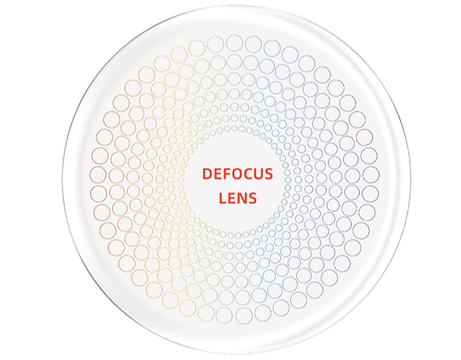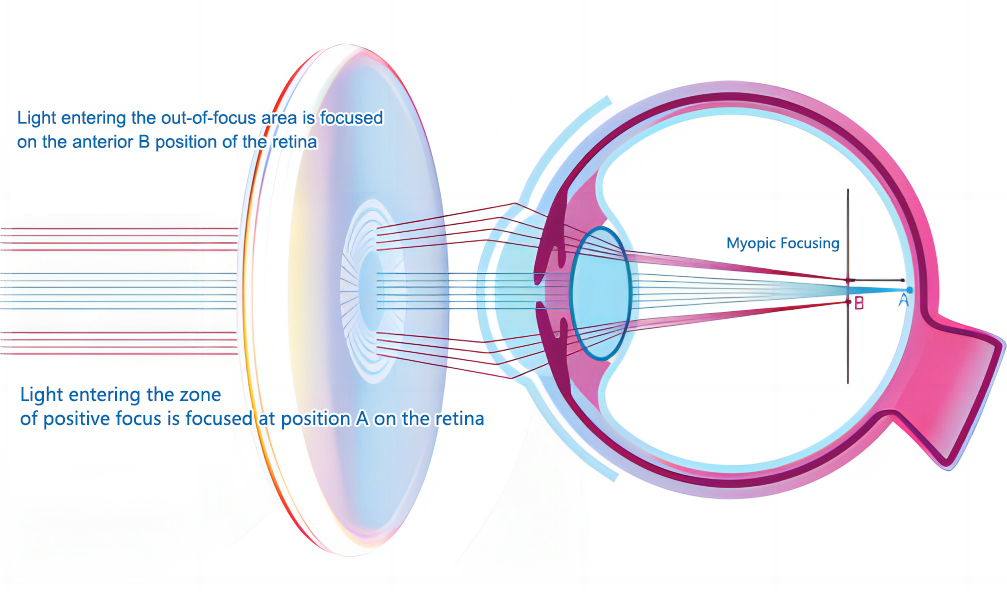咨询热线15358615566
咨询热线15358615566
| INDEX | Abbe | Specific Gravity | Design | Coating | Coating Color | UV Cut (nm) | Power Range | Crowd |
| 1.591PC | 32 | 1.28 | D.I.M.S (defocus incorporated multiple segments) | HMC/SHMC | Green/Blue | 400/420++ | Sph:-0.00~-6.00 Cyl:-0.00~-2.00 | ≤16 YEARS OLD |
| 1.56 | 35.5 | 1.32 | D.I.M.S (defocus incorporated multiple segments) | HMC/SHMC | Green/Blue | 400/420++ | Sph:-0.00~-6.00 Cyl:-0.00~-2.00 | ≤16 YEARS OLD |

Desigh:D.I.M.S(defocus incorporated multiple segments)
"Defocus" refers to the situation where the focal point formed by parallel light passing through the refractive medium does not fall on the retina. "If the focus falls in front of the retina, it corresponds to what is commonly referred to as myopia. This defocus state is called myopic defocus (or positive defocus). Conversely, if the focus falls behind the retina, it corresponds to a hyperopia state. This defocus is called hyperopia defocus (or negative defocus)."
The relationship between defocusing and myopia is a well-known theory of peripheral defocusing proposed by Professor Earl Smith, dean of the College of Optometry at the University of Houston in the United States at the end of the last century.He found that during the formation of myopia in children and adolescents, the fovea of the retina in myopic patients presents myopic defocus (positive defocus), while the periphery of the fovea of the retina presents hyperopic defocus (negative defocus). Retinal hyperopia defocus is the main cause of increasing retinal power.
When hyperopia defocus occurs, especially when children's peripheral scenery is imaged behind the retina for a long time, it can create an illusion to the brain that the eye axis is too short, so the brain will send a signal to the eye axis to continue to grow, leading to sustained lengthening of the eye axis. Research has shown that most myopia is caused by the lengthening of the eye axis, and the normal 1mm myopia degree of the eye axis will increase by -3.00 °, and myopia caused by this factor cannot be avoided and reversed.


After myopia occurs, refractive correction is necessary. Although traditional single lens lenses can correct central vision, they can affect the imaging quality of the peripheral retina. The central object is projected onto the central fovea of the retina, and its periphery is projected onto the rear of the retina, which will promote the retinal membrane to elongate backward, accelerating the speed of eye axis elongation.
Applying a positive defocus (focusing in front of the retina) to the developing eye and letting this focus fall in front of the retina, the brain will send a signal to prevent the backward growth of the eye, ultimately achieving the goal of controlling the growth of the eye axis and delaying the development of myopia PS:The research results show that in order to slow down the growth of the eye axis, the applied myopic defocus stem pre stress occurs within a field angle of 20 ° from the central fovea of the retina. When the applied myopic defocus occurs within a field angle of 15 ° from the central fovea of the retina, the effect is best.
Microlenses with different defocusing amounts in the each circle gradually decrease from the inner circle to the outer circle, which has a better intervention effect on eye axis growth.
The more the number of micro convex lenses, the better. Changes in defocus lenses. The defocus lenses are distributed at a viewing angle of 15° - °20, fully meeting the defocus amount required by the eyeball.
Prescription multi-point defocus lenses worn by myopic patients with a variable defocus amount have a better effect on delaying the deepening of myopia than multi-point defocus lenses with a fixed defocus amount.
